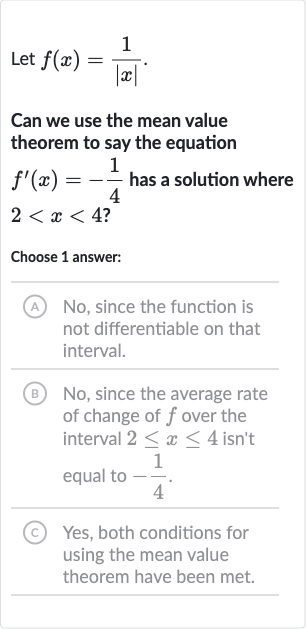AI tutor
Welcome to Bytelearn!
Let’s check out your problem:

Let .Can we use the mean value theorem to say the equation has a solution where \( 2
Full solution
Q. Let .Can we use the mean value theorem to say the equation has a solution where ?Choose answer:(A) No, since the function is not differentiable on that interval.(B) No, since the average rate of change of over the interval isn't equal to .(C) Yes, both conditions for using the mean value theorem have been met.
- Mean Value Theorem Conditions: The Mean Value Theorem states that if a function is continuous on the closed interval and differentiable on the open interval , then there exists at least one in the interval such that is equal to the average rate of change of over . We need to check if meets these conditions on the interval .
- Continuity Check: First, we check if is continuous on the closed interval . Since is never zero for in , is continuous on .
- Differentiability Check: Next, we need to check if is differentiable on the open interval . The function is not differentiable at , but since is not in the interval , we need to consider the differentiability elsewhere. The absolute value function causes a problem at , but since we are considering the interval , where is always positive, we can write as for this interval. The derivative of is , which is defined for all in .
- Average Rate of Change Calculation: However, we must remember that the Mean Value Theorem requires the function to be differentiable on the entire open interval . The function is not differentiable at , and although is not in the interval , we must consider the behavior of the function at the endpoints to ensure there are no points of non-differentiability. Since is not differentiable at , and involves , we must conclude that is not differentiable at . However, this does not affect the differentiability on the interval since is not within this interval.
- Conclusion: Now, we calculate the average rate of change of over the interval . The average rate of change is given by , where and . So, we have:The average rate of change is:
- Conclusion: Now, we calculate the average rate of change of over the interval . The average rate of change is given by , where and . So, we have:The average rate of change is:The average rate of change of over the interval is , which is not equal to . Therefore, the Mean Value Theorem cannot guarantee that there is a number in the interval such that because the average rate of change is not equal to .
More problems from Power rule with rational exponents
QuestionGet tutor help
QuestionGet tutor help
QuestionGet tutor help
QuestionGet tutor help
QuestionGet tutor help
